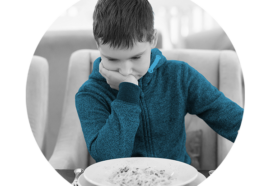Authors: Dr. Nora Trompeter 1, and Dr. Tom Jewell2
1Post-doctoral research fellow, King’s College London
2Lecturer in Mental Health Nursing, King’s College London
Last year the government introduced the out-of-home calorie labelling policy in England to help people make informed nutritional decisions as part of a broader strategy to reduce rates of obesity. However, little is known about how this policy impacts young people’s mental health, especially those with lived experience of eating disorders. Here we summarise the existing research and highlight areas for further investigation.
Background:
Calorie labelling on menus is a policy that has been introduced in several Western countries, including parts of Australia, Canada and the United States. In England, new regulations came into effect in April 2022 requiring large businesses (i.e., >250 employees) to provide calorie labelling on their non-prepacked food and soft drinks (Department of Health, 2021). While these regulations aim to reduce population levels of obesity, concerns have been raised about the negative impact on people with eating disorders (Beat, 2020).
What are eating disorders?
Eating disorders are mental health disorders that involve disordered eating and weight control behaviours (e.g., dietary restraint, binge eating), and are often accompanied by high levels of body dissatisfaction. It is estimated that around 1.25 million people in the UK have an eating disorder. Concerningly, hospitalisations for severe eating disorders have risen by 84% in the last five years (Royal College of Psychiatrists, 2022). Eating disorders typically develop during adolescence, with a peak age of onset at 15.5 years (Solmi et al., 2021). In addition, many adolescents experience symptoms of eating disorders, with around 25% of adolescents reporting significant concerns about their weight or shape (Hughes et al., 2019) and 20% engaging in disordered eating (López-Gil et al., 2023).
Impacts of anti-obesity policies
Preventing obesity is a top priority in efforts to improve public health among many Western countries. In parallel, there have been calls within the eating disorder field to align efforts to reduce obesity with efforts to prevent eating disorders (Sánchez-Carracedo et al., 2012). Concerns have been raised that policies not informed by eating disorder prevention could cause harm to both people with lived experience of eating disorders, and those at risk of developing eating disorders (Hay & Mitchison, 2019).
Existing research on calorie-labelling found that people who said that they used calorie labels in restaurants to limit calorie intake were more likely to also report weight-related concerns, dieting and unhealthy weight-control behaviour – although it is not clear if there is a causal link between calorie labelling and these behaviours (Larson et al., 2018). Among people with eating disorders, an experimental study using hypothetical calorie-labelling scenarios found that people with an eating disorder select food that is either lower or higher in calories compared to people without an eating disorder (Haynos & Roberto, 2017). Specifically, people with restrictive eating (e.g., anorexia nervosa) tended to select foods with fewer calories. In contrast, people with binge eating (i.e., binge eating disorder), selected food items with significantly more calories.
Qualitative research also finds similar results. In a study of American university students, 16% reported concerns that these types of labels could cause an eating disorder, and 47% reported concerns that labels could exacerbate existing eating disorders (Seward et al., 2018). Analyses of responses on Twitter to the policy implementation in England further found that concerns for people with eating disorders were the most commonly reported (Jones et al., 2022). Thus, when assessing the potential impact of the calorie labelling regulation, we need to consider both the impact on future eating disorder symptoms and people with lived experience of eating disorders.
Impact: Risk factor for eating disorder symptoms
A common concern when it comes to policies to reduce obesity, is the focus on weight as a sole indicator of health. Research showed that exposure to anti-obesity messaging (e.g., public health advertising) perpetuated the belief that slim body types are more desirable than larger body types (Bristow et al., 2020), a key factor for developing eating disorders (Barakat et al., 2023). As such, the calorie labelling policy could reinforce the idea that high weight is negative and that one’s weight is an individual’s responsibility. Hence, if someone has a higher weight it could lead to feelings of guilt or stigma.
Similarly, focusing purely on calories may encourage calorie counting and tracking (Beat, 2020), behaviours linked to eating disorder development. Importantly, young people may be impacted the most by such policies, as they tend to be more vulnerable to societal messaging and stigma (Heary et al., 2017). However, research on young people specifically is very limited so we do not know how this policy impacts this population.
Impact: Eating disorder maintenance
Many of the concerns voiced regarding the current calorie labelling regulations stem from people with lived experience of eating disorders. Recovering from eating disorders requires changes in behaviours, thinking patterns, and coping skills (Bohrer et al., 2020). However, these processes can be challenging, especially when people are faced with conflicting messages through public discourse. People recovering from eating disorders often highlight the difficulty of navigating their recovery when faced with anti-obesity messaging and cultural norms around dieting and thinness (Kenny et al., 2020; Lamarre & Rice, 2016). This is especially challenging for people with diverse body types, for example, those living in larger bodies. Calorie counting is a common behaviour in people with eating disorders (Simpson & Mazzeo, 2017), so letting go of this behaviour in recovery could be made more difficult when immersed in environments that constantly remind people of the caloric content of food.
Conclusion
In reviewing the existing evidence of calorie labelling regulations, especially for young people, two things are clear:
Firstly, much more research is needed to understand how the current regulation impacts young people. Notably, to our knowledge, no research to date has examined how young people with lived experience of eating disorders can best navigate the current regulations.
Secondly, efforts to reduce obesity should be informed by eating disorder prevention. With many governments globally considering different policies and regulations to tackle obesity, it will become increasingly important to consider how these will impact rates of eating disorders.
Conflict of interest
Nora Trompeter and Tom Jewell currently have a grant under review for the National Institute for Health and Care Research (NIHR) Policy Research Programme targeted call to understand the impact of the Out of Home Calorie Labelling Regulations on people with lived experience of eating disorders.

Dr. Nora Trompeter is a post-doctoral research fellow at King’s College London. Nora’s research is focused on understanding how eating disorders develop in adolescents. Her other research interests include stigma and help-seeking, and childhood adversities.

Dr. Tom Jewell is a Lecturer in Mental Health Nursing at King’s College London, with a clinical and research interest in adolescent eating disorders. He is a mental health nurse and family therapist, and works clinically at Great Ormond Street Hospital.
References
- Barakat, S., McLean, S. A., Bryant, E., Le, A., Marks, P., Aouad, P., Barakat, S., Boakes, R., Brennan, L., Bryant, E., Byrne, S., Caldwell, B., Calvert, S., Carroll, B., Castle, D., Caterson, I., Chelius, B., Chiem, L., Clarke, S., … Maguire, S. (2023). Risk factors for eating disorders: findings from a rapid review. Journal of Eating Disorders, 11(1), 8. https://doi.org/10.1186/s40337-022-00717-4
- Beat. (2020). Mandatory calorie labelling on menus would harm people with eating disorders. https://beat.contentfiles.net/media/documents/Briefing_-_Calorie_Labelling_on_Menus_.pdf
- Bohrer, B. K., Foye, U., & Jewell, T. (2020). Recovery as a process: Exploring definitions of recovery in the context of eating-disorder-related social media forums. International Journal of Eating Disorders, 53(8), 1219–1223. https://doi.org/10.1002/eat.23218
- Bristow, C., Meurer, C., Simmonds, J., & Snell, T. (2020). Anti-obesity public health messages and risk factors for disordered eating: a systematic review. Health Promotion International, 35(6), 1551–1569. https://doi.org/10.1093/heapro/daaa018
- Department of Health. (2021). The Calorie Labelling (Out of Home Sector) (England) Regulations 2021. Houses of Parliament. https://www.legislation.gov.uk/uksi/2021/909/contents/made
- Hay, P., & Mitchison, D. (2019). Eating disorders and obesity: The challenge for our times. In Nutrients (Vol. 11, Issue 5). https://doi.org/10.3390/nu11051055
- Haynos, A. F., & Roberto, C. A. (2017). The effects of restaurant menu calorie labeling on hypothetical meal choices of females with disordered eating. International Journal of Eating Disorders, 50(3), 275–283. https://doi.org/10.1002/eat.22675
- Heary, C., Hennessy, E., Swords, L., & Corrigan, P. (2017). Stigma towards Mental Health Problems during Childhood and Adolescence: Theory, Research and Intervention Approaches. Journal of Child and Family Studies, 26(11), 2949–2959. https://doi.org/10.1007/s10826-017-0829-y
- Hughes, E. K., Kerr, J. A., Patton, G. C., Sawyer, S. M., Wake, M., le Grange, D., & Azzopardi, P. (2019). Eating disorder symptoms across the weight spectrum in Australian adolescents. International Journal of Eating Disorders, 52(8), 885–894. https://doi.org/10.1002/eat.23118
- Jones, A., Polden, M., & Robinson, E. (2022). Assessing public perception and awareness of UK mandatory calorie labelling in the out-of-home sector: using Twitter and Google trends data. PsyArXiv. https://doi.org/10.31234/osf.io/t6bhy
- Kenny, T. E., Boyle, S. L., & Lewis, S. P. (2020). #recovery: Understanding recovery from the lens of recovery-focused blogs posted by individuals with lived experience. International Journal of Eating Disorders, 53(8), 1234–1243. https://doi.org/10.1002/eat.23221
- Lamarre, A., & Rice, C. (2016). Normal Eating Is Counter-Cultural: Embodied Experiences of Eating Disorder Recovery. Journal of Community and Applied Social Psychology, 26(2), 136–149. https://doi.org/10.1002/casp.2240
- Larson, N., Haynos, A. F., Roberto, C. A., Loth, K. A., & Neumark-Sztainer, D. (2018). Calorie Labels on the Restaurant Menu: Is the Use of Weight-Control Behaviors Related to Ordering Decisions? Journal of the Academy of Nutrition and Dietetics, 118(3), 399–408. https://doi.org/10.1016/j.jand.2017.11.007
- López-Gil, J. F., García-Hermoso, A., Smith, L., Firth, J., Trott, M., Mesas, A. E., Jiménez-López, E., Gutiérrez-Espinoza, H., Tárraga-López, P. J., & Victoria-Montesinos, D. (2023). Global Proportion of Disordered Eating in Children and Adolescents: A Systematic Review and Meta-analysis . JAMA Pediatrics. https://doi.org/10.1001/jamapediatrics.2022.5848
- Royal College of Psychiatrists. (2022). Hospital admissions for eating disorders increased by 84% in the last five years. Royal College of Psychiatrists. https://www.rcpsych.ac.uk/news-and-features/latest-news/detail/2022/05/18/hospital-admissions-for-eating-disorders-increased-by-84-in-the-last-five-years
- Sánchez-Carracedo, D., Neumark-Sztainer, D., & López-Guimerà, G. (2012). Integrated prevention of obesity and eating disorders: Barriers, developments and opportunities. In Public Health Nutrition (Vol. 15, Issue 12, pp. 2295–2309). https://doi.org/10.1017/S1368980012000705
- Seward, M. W., Block, J. P., & Chatterjee, A. (2018). Student experiences with traffic-light labels at college cafeterias: a mixed methods study. Obesity Science and Practice, 4(2), 159–177. https://doi.org/10.1002/osp4.159
- Simpson, C. C., & Mazzeo, S. E. (2017). Calorie counting and fitness tracking technology: Associations with eating disorder symptomatology. Eating Behaviors, 26, 89–92. https://doi.org/10.1016/j.eatbeh.2017.02.002
- Solmi, M., Radua, J., Olivola, M., Croce, E., Soardo, L., Salazar de Pablo, G., il Shin, J., Kirkbride, J. B., Jones, P., Kim, J. H., Kim, J. Y., Carvalho, A. F., Seeman, M. v, Correll, C. U., & Fusar-Poli, P. (2021). Age at onset of mental disorders worldwide: large-scale meta-analysis of 192 epidemiological studies. Molecular Psychiatry. https://doi.org/10.1038/s41380-021-01161-7



